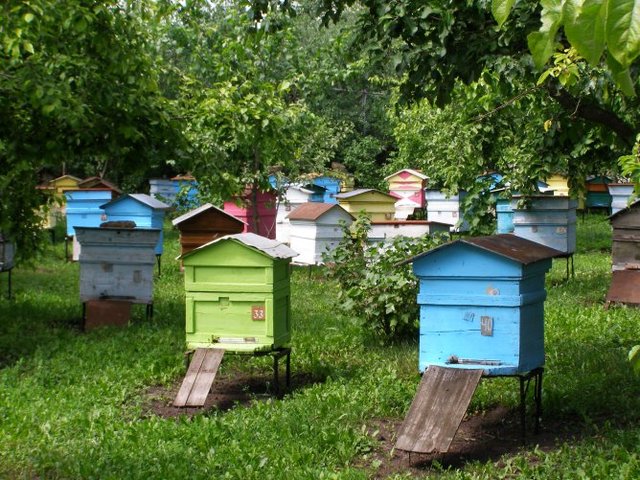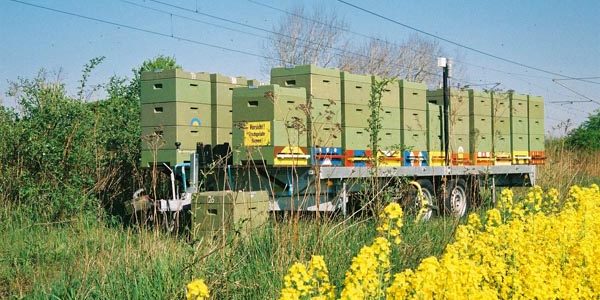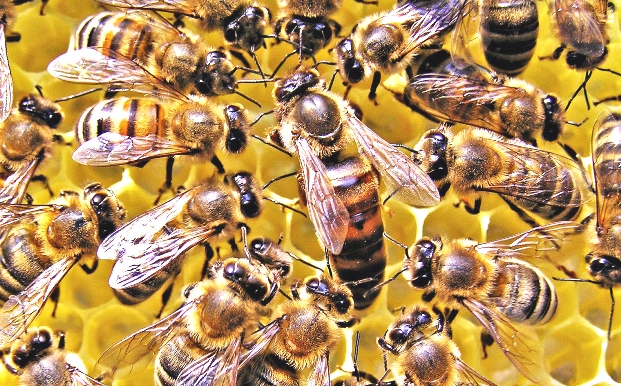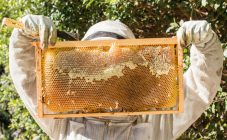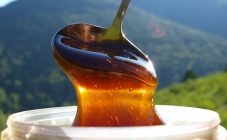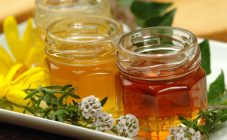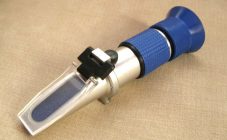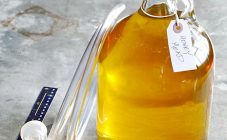Content:
Natural honey is a very valuable and demanded product. Apiary management is one of the most ancient crafts that our ancestors were successfully engaged in. This activity can bring a good income in the summer months, but it requires a lot of attention, special knowledge, work and patience. Only by making significant efforts and studying the intricacies of the beekeeper's work can you expect good results.
Apiary productivity indicators
Apiary management is a rather unpredictable activity, the results and profitability of which depend on many factors. Even the most experienced beekeeper cannot accurately predict the future honey harvest. There are only rough calculations of how much honey can be collected from one hive per season.
If the calculation is carried out for a medium-sized hive of 12 frames, then it is assumed that one and a half kilogram of honey can be formed on one frame.
By simple counting, the yield of honey is 12-18 kg. But in practice, the frames are not always completely filled, and the beekeepers cannot completely pump out the honey. As a result, the product yield is 12-15 kg of honey, and this is a very good result. Especially considering the fact that bees fill the frames several times over the summer. The total amount of honey that can be collected in a favorable season is 70-100 kg from one medium-sized hive. Experienced beekeepers who use new technologies for caring for bees, breed strong families, develop the most suitable hive design, can receive up to 200 kg of honey from one hive.
Depending on how much honey one hive gives per season, you can calculate its productivity. A hive is considered profitable, from which it turns out to pump more than 10 kg of product.
Factors affecting the volume of honey
The production of honey by bees is a seasonal process. Throughout the summer and warm spring days, these workers prepare a sweet product for the whole year as food for offspring for the whole winter. It is believed that the average bee colony consumes up to 10 kg of feed per winter. A person keeps the surplus for himself.
Beekeeping is a rather complex craft, the performance of which is influenced by various factors:
- The region in which the apiary is located. The main characteristics are climatic conditions: the duration and severity of winter, the timing of the onset of spring, especially the summer period, the number of sunny days. For each climatic zone, a breed of insects is recommended that is most adapted to its conditions. The most adapted breeds in Russia are the Caucasian, Central Russian, Carpathian and Ukrainian bees. The warmer and longer the summer, the more honey you can collect. In the southern regions, beekeepers pump it out up to 10 times per season.
- Honey base. This is the basis for the production and quality of honey. Bees must collect pollen and nectar from flowers. The best option for the location of the apiary is an orchard, forest edge, sown fields. The presence of bees has an excellent effect on the growth and development of melliferous plants - insects collect nectar and pollinate them, as a result of which the quality of the future harvest increases significantly. Willow, clover, alfalfa, dandelions, sunflowers, and lavender are excellent honey plants. But lime and buckwheat honey is considered the most beloved, aromatic and useful.
- Hive dimensions. The largest volumes of honey can be produced by spacious multi-hives. This helps to avoid overheating.
A very dangerous factor for the life of bees is the treatment of trees, flowers, crops with pesticides. These insects are very sensitive to such substances and, if insecticides are used during flowering, this leads to their mass death.
Factors contributing to honey production
In addition to natural factors that affect the amount of honey collected, proper care for insects plays a significant role in increasing the productivity of bees.
- The bee breed is the basis for the future productivity of the apiary. The quality of bee colonies and their ability to work depend on the viability of bees in a particular region. For insects to live in the conditions of central Russia, they must have such characteristics as winter hardiness, low tendency to swiftness, and good working capacity in spring. In addition, bees must have immunity to nosematosis and toxemia.
- Good nutrition for bees. Often, beekeepers use sugar syrups to feed bees in order to save honey or because of insufficient honey reserves. Such a diet negatively affects the working capacity of insects - they can stay in the air for no more than half an hour and fly away from the hive no further than 500 m. On high-quality feed, a bee can fly for more than 3 hours and move 2 km. As a result, a large amount of honey can be obtained. In addition, such bees live much longer, and the period of their productivity increases.
- Proper preparation of bees for the winter period. For a comfortable transfer of winter and readiness for an early bribe, beekeepers recommend feeding the bees already in the period from August 1-20. Thus, bees endure winter better, gain a large fat body. To prepare feed for wintering, the ratio of sugar to natural honey should be maintained - 40% * 60%. At the same time, at the initial stage, you need to feed sugar honey, and use natural honey in the second half of winter. With this tactic, during the onset of brood and its development, adults and larvae feed on a natural product, which has a good effect on the quality and life of the bee colony.
- Swarming bees. In other words, the breeding process. The beekeeper should be very careful not to miss the beginning of this process - the bees first swarm over the hive, resembling a cloud, and then leave it and settle nearby. In order not to lose the whole family, the beekeeper must catch the queen and run it into a separate building. More experienced beekeepers do not allow swarming - bees need to be loaded with work. To do this, carefully and constantly remove the sealed honeycomb and replace them with empty ones. This is a signal to the bees that there is not enough food for the winter, and they harvest it again, postponing the start of reproduction.
Another advice from experienced beekeepers is that several spare queens should be put into the hive for the winter. This trick works well during the "downtime" period, when the flowering period of some melliferous plants is over, while others have not yet begun. To prevent the bees from swarming, the printed brood is taken from them and placed in reserve queens in exchange for the open brood.Thus, the main bee colony is busy processing the product before the honey harvest begins. And by the next season, several young families can often leave with the help of spare queens.
- Spare honeycomb. During active honey collection, the availability of a large number of spare cells plays a decisive role in obtaining an effective honey volume. Bees devote all their energy to collecting nectar and pollen, not building honeycombs. In addition, by observing empty combs, bees will work hard to fill them. If the honeycomb is not in sufficient quantity, the insects will stop working, since there will be no way to put the nectar. Sometimes, during the peak of active collection, it is even possible to remove incompletely filled cells and replace them with empty ones. The fact is that nectar contains a large amount of moisture - about half. In the finished product, the moisture content should not exceed 20%. Bees spend a lot of time and energy in processing nectar. Therefore, in order for the moisture to evaporate faster, they scatter the collected product loosely over the entire surface of the honeycomb.
- Competent selection of honey frames. Experienced beekeepers know: it is impossible to select honeycombs with honey during the day. Thus, the work of the bees to collect the nectar is stopped. They begin to put things in order in the hive, get used to new conditions, calm down. The optimal time for removing honey frames is evening or, if there is a covered pavilion with electricity, at night. Insects are calm, sleepy. There is an opportunity to take a good look at the hive, clean it, change the honeycomb.
How much honey does one bee bring?
In order to better imagine how much honey one individual can bring, you need to make certain calculations. One gram of honey = two grams of nectar. For one spoonful of product in the amount of 30 g, you need to collect 60 g of nectar. For one bribe, a bee is able to bring only 30 mg of nectar. This means that in order to receive one spoonful of honey, a bee needs to make 2,000 bribes. Considering that one bee can fly 10 times a day, it can be argued that 200 bees must work all day to collect one spoonful of honey.
Only by imagining the entire volume of work invested in such a familiar product to us, one can understand how hard-working bees are. But this result is real only if the bee colony is strong enough.
A strong colony is a colony that is characterized by great efficiency. Bees fly out to gather in the morning and work all day until evening. Especially productive families are able to collect honey even in cloudy and rainy weather.
Strong bee colony resistant to diseases, especially varroatosis, tolerates cold well, numbers about 50 thousand individuals.
Methods to increase honey production
To increase the amount of honey production, experienced beekeepers use additional methods of bee care:
- Enrich food with vitamin supplements;
- Develop new designs of hives;
- Brood larvae are culled;
- Install grids to collect garbage;
- Electric heaters are used;
- Install the upper entrances;
- Feeding with flower syrup is carried out.
Beekeeping is a fairly painstaking and laborious occupation that requires special knowledge and patience. But the one who decided to study this craft and treats it with a soul receives in return a great influx of energy, calmness and warmth.In addition to the pleasure gained from communicating with bees, this activity can bring a good income.
